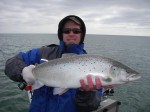
I come from a fish biology background so proper catch and release practices are important to me. During my time with the Oregon Department of Fish and Wildlife, I worked at a fish ladder on the North Santiam river. My job was to enumerate and ID salmonids that passed through the main ladder near Stayton, Oregon. This required me to capture and handle all spring chinook and summer steelhead that passed through the ladder. During the several years that I worked this ladder, I handled many thousands of large salmon and steelhead. This experience with "catch and release" gave me an appreciation for the proper handling of large salmonids.
I also went through a 7 year "fly fishing only" phase. Much to the chagrin of my two "gut slinging" brothers, I adopted the stereotypical elitist attitude of many fly fisherman. But there were some important lessons learned during this time. One of the positive things gleaned was an appreciation for how to hold and handle a trout during the photograph and release session. These lessons would cross over into my new "trophy trout" phase.
I am going to break everything down step by step from hooking to release in this article. These are my opinions based upon much research and experience. This article is geared specifically for the trophy trout angler. Trout are more sensitive than we think. Just because a fish swims off doesn't mean that it is going to make it.
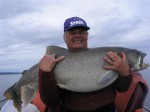 Ok, it all starts out with the hookup and fight of the fish. As the fish struggles, lactic acid builds up in the muscular regions of the fish. I am not going to go into all of the physiological factors that come into play, but basically, there are three main factors that we need to be aware of. Time of struggle, water temperature and size of fish. You can see why we, as trophy trout anglers need be extra concerned. We are targeting larger trout and more often then not we are playing them on a light drag for fear of pulling a hook or breaking a fish off. Summertime fish can be especially susceptible to stress induces by catch and release. Once a fish reaches "acidosis", or a point where the lactic acid buildup is non reversible, it is only a matter of time before they die. Many anglers release fish thinking that they will survive when, in fact, the fish will die a few days later due to issues created during the fight and release. Ok, it all starts out with the hookup and fight of the fish. As the fish struggles, lactic acid builds up in the muscular regions of the fish. I am not going to go into all of the physiological factors that come into play, but basically, there are three main factors that we need to be aware of. Time of struggle, water temperature and size of fish. You can see why we, as trophy trout anglers need be extra concerned. We are targeting larger trout and more often then not we are playing them on a light drag for fear of pulling a hook or breaking a fish off. Summertime fish can be especially susceptible to stress induces by catch and release. Once a fish reaches "acidosis", or a point where the lactic acid buildup is non reversible, it is only a matter of time before they die. Many anglers release fish thinking that they will survive when, in fact, the fish will die a few days later due to issues created during the fight and release.
After we get the fish to the net there are other concerns. When netting a trout you want to try to use a net with either rubber or coated nylon mesh. Rubber meshed nets are very heavy in the water so I recommend a coated mesh for trophy trout angling. Standard thin mesh nets wreak havoc on the trout's protective slime coat and slice caudal fin rays to shreds. Try to use a net with a large enough bag to allow the trout to rest in the water while you are working on getting the hooks out.
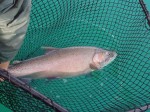 Once the fish is in the bag and the yells and high fives subside, the next step is to get the hooks out of the fish. Don't worry about getting the hooks out of the net mesh until after you have freed the fish. Try to keep the fish fully submerged as you work on the hooks. I like to use long needle-nosed pliers to work the hooks out. Gently, but firmly work each hook out, trying to do as little damage to the fish as possible. Once the hooks are completely free of the fish and he is resting comfortably in the bag of the net, you can focus on freeing the lure from the net mesh. Once the fish is in the bag and the yells and high fives subside, the next step is to get the hooks out of the fish. Don't worry about getting the hooks out of the net mesh until after you have freed the fish. Try to keep the fish fully submerged as you work on the hooks. I like to use long needle-nosed pliers to work the hooks out. Gently, but firmly work each hook out, trying to do as little damage to the fish as possible. Once the hooks are completely free of the fish and he is resting comfortably in the bag of the net, you can focus on freeing the lure from the net mesh.
But what about the "tiddlers" you ask? Well, when a small fish is hooked and landed, the best way to release it is to not even touch the fish at all. Just twist and maneuver the hooks out as the small fish is in the water near the boat. Control the fish with the other hand via your fishing line. You should be able to "pop off" 95% of your small trout with hardly any damage to the fish and you never having to touch him.
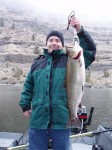 I personally do not like boga grips or their derivatives for trout. They were designed for largemouth bass and other species with a totally different mouth structure. I cringe every time I see a large trout hanging from grippers, its backbone stretched to the breaking point at the nuchal (nape) of the trout's neck. If you look carefully, you might even see a dark spot at the nuchal region the neck where internal contusion is occurring. Many of these fish will die in the next day or so, unbeknownst to the angler who "released" the fish. I personally do not like boga grips or their derivatives for trout. They were designed for largemouth bass and other species with a totally different mouth structure. I cringe every time I see a large trout hanging from grippers, its backbone stretched to the breaking point at the nuchal (nape) of the trout's neck. If you look carefully, you might even see a dark spot at the nuchal region the neck where internal contusion is occurring. Many of these fish will die in the next day or so, unbeknownst to the angler who "released" the fish.
Some of the grippers have "jaws" designed to hold the fish. These jaws are great at crushing and destroying trout's mouth bones. If a fish thrashes while in the clutches of this style of gripper, you can do some terrible damage to the fish. Many anglers like grippers because you don't have to touch the water or fish and can control the fish easily. The only situation that I would recommend a gripper is if the trout if under 5 pounds and you only used a boga grip style device to control the fish for ease of handling.
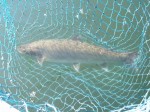 Ok, we now have the hooks out of the fish and it is resting comfortably in the large bag of the net. We cut our line just above the lure and have been able to untangle the hooks from the mesh of the net and set our lure aside. Now it is time to weigh our fish. I like digital scales. They are easy to read and there is no mistaking what the scale says. The better ones are accurate enough for most situations and if you ever had a fish that was right at 10 pounds you could always pull out a more precise scale. Ok, we now have the hooks out of the fish and it is resting comfortably in the large bag of the net. We cut our line just above the lure and have been able to untangle the hooks from the mesh of the net and set our lure aside. Now it is time to weigh our fish. I like digital scales. They are easy to read and there is no mistaking what the scale says. The better ones are accurate enough for most situations and if you ever had a fish that was right at 10 pounds you could always pull out a more precise scale.
Most digital scales have a tare preset that will allow you have have the weight of your net already tared. So, hook the scale to the mesh of your net near the handle and lift the fish out of the water until you have a steady weight. In a perfect world you would never have the fish out of the water for more than 20 seconds at a time. After you get a solid weight that you are comfortable with you can get a length and girth if you so desire. Measure both length and girth with the fish in the net bag. Use a wetted soft measuring tape if possible. After you get your measurements you can get get prepped for "camera time".
I usually wear a thin cotton glove when I handle a large fish. While working in the fish trap on the North Santiam River I learned the importance of controlling a fish. Without a cotton glove, there will be that time when a large fish thrashes out of your grasp and drops into the water or onto the floor of your boat, neither good situations. A large trout flopping on the deck of your boat is about as bad a situation as you can have if you intend to release that fish.
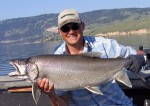 Always, wet your glove or hand before you handle the fish. This helps protect the fish from damage to its slime coating. The preferred method of photographing a large trout is to have one hand controlling the fish at the wrist of the tail and the other supporting the fish near its mid-section. Never hold a fish by the gill plate! Trout are used to having their body weight supported by the neutral weight of their water environment. A vertical hold on a large trout will put pressure on all of the internal organs and can do permanent damage that the angler may never suspect. Always, wet your glove or hand before you handle the fish. This helps protect the fish from damage to its slime coating. The preferred method of photographing a large trout is to have one hand controlling the fish at the wrist of the tail and the other supporting the fish near its mid-section. Never hold a fish by the gill plate! Trout are used to having their body weight supported by the neutral weight of their water environment. A vertical hold on a large trout will put pressure on all of the internal organs and can do permanent damage that the angler may never suspect.
Have your buddy or self timer ready to go with the camera and pull the fish out of the net for the photo session. Get that fish back into the net and water after 20 seconds or so. Repeat until you get the shot that you want.
Now for the release. By this time, your fish should be getting revived via the time in the bag of the net. Gently remove him and work him slowly back and forth in the water, keeping a gentle grasp on the caudal peduncle (wrist of the tail). You will feel the fish try to kick free of your grasp. If he can power out of your grasp that is a good sign. Keep working the fish until you are confident that he is recovered enough to swim away strongly. Hopefully the fish will power down and away. A fish swimming off on the surface is not a good sign.
If the fish is bleeding from any portion of its gills then the fish will certainly die. Don't kid yourself! Studies have shown that any blood coming from the gill region equals certain death. If the fish is bleeding from it mouth area then it will probably be fine. If you don't think the fish will survive then it is best to keep it. There is not point in wasting the fish.
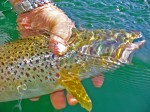 I prefer to release 99.9% of the trout I catch. I have fished with others who keep anything over 5 pounds. Though I support CPR (catch, photograph, release) wholeheartedly, the decision to keep or release a fish is up to the individual. I will tell you that a properly handled fish swimming to its freedom can leave you with a great feeling of satisfaction. I prefer to release 99.9% of the trout I catch. I have fished with others who keep anything over 5 pounds. Though I support CPR (catch, photograph, release) wholeheartedly, the decision to keep or release a fish is up to the individual. I will tell you that a properly handled fish swimming to its freedom can leave you with a great feeling of satisfaction.
**A note for mackinaw anglers regarding inflated air bladders. In my opinion, the most effective way to release a lake trout with a distended air bladder is via the following method. Have a large single hook without a barb that has a short length of heavy mono tied to the center of the bend of the hook ready. Attach this rig to your downrigger ball. Push the barbless hook down through the top of the snout and drop the fish via your downrigger back to the depth at which you caught him. After a minute or two you can run the downrigger ball up and that will pull the hook out of the top of the mouth and release the fish. Or, if you have a pinch release on your downrigger you can actually lightly clip the jaw of the fish into the release and smoothly drop him down. They can usually shake off once they revive down at depth. Only use the needle method as a last resort. Studies have shown that needle deflated fish have a poor survival rate if the method isn't done correctly, and even with the proper techniques there is a reasonably high associated mortality.
Mark K.
Team TTG
|